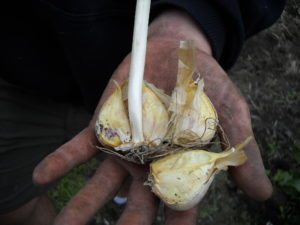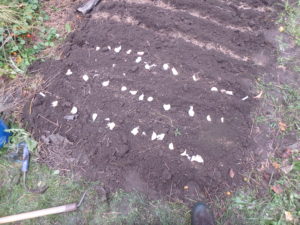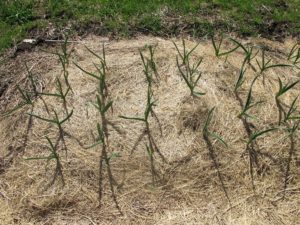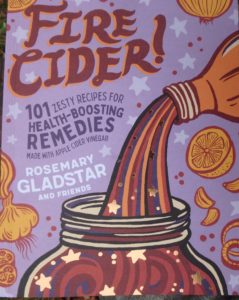Now is the Time to Plant Garlic!
Posted on Thursday, October 24, 2019 · Leave a Comment
The easiest crop I grow every year is garlic. I plant it in October, mulch it well, and harvest it in early August. That’s it. If it’s well mulched, I don’t even have weed the bed more than once or twice. Not only that, I use this year’s harvest to plant next year’s crop, so it’s free. Each year my garlic crop gets better as I use the best of this year’s harvest to plant next year’s crop. My garlic is well adapted to my soil and climate.
If you want to grow garlic but don’t have any for planting, you can buy some “seed garlic” on-line, or you can check with a local farm stand for garlic you can plant. Don’t use grocery store garlic. Much commercial garlic has been treated with chemicals to prevent sprouting. And most grocery store garlic is the wrong kind for planting in New England – and some of it is from China. I avoid anything grown in China, due to concerns about toxic chemicals used there.
There are two basic categories of garlic: soft neck garlic and hard neck garlic. Grocery store garlic is usually soft neck, the kind you see braided and hung up in Italian restaurants. It is less hardy than hard neck garlic, a bit bland and less interesting to cook with.

Hardneck Garlic ready for planting
Here in New England we should plant hard neck garlic, which has a stiff “scape” or stem that starts in the middle of the bulb, and grows up as the stalk and produces a flower in July. The fresh scapes can be cut and used in sauces or omelets.
To plant garlic, begin by selecting a bed in full sunshine. Weed it well and make sure the soil is loose and fluffy. In a bed 24- to 30-inches wide I plant 3 rows of garlic. I make furrows with a hand tool or hoe and add some organic fertilizer which I then stir into the soil.
Divide a bulb of garlic into individual cloves for planting. Mine vary from 4 or 5 cloves per bulb up to a dozen. Most have 6 or 8 cloves per bulb. I plant my cloves a hands-width apart, which is about 5 inches. I push each bulb into the soil so that the bottom of the clove is about 3 inches deep, or with the tips 2 inches from the soil surface.

Place your garlic cloves on the soil to establish space before planting
When I plant the second row I stagger the cloves so that they are not lined up with the first row. In the third row I match the cloves with those in the first row. Staggering the bulbs insures a little extra space between bulbs. When all are in the soil I push soil over the cloves and pat the soil down with my hands. If your soil is sandy or a heavy clay, adding some compost before planting is good.
The last step is mulching your bed. You can use straw or mulch hay. Straw should not have any seeds, but it is much more expensive to buy – usually more than $10/bale. Mulch hay is just hay for cows that got wet and is no longer tasty to them. It should be under $5/bale.
Take a section of a bale and shake it over the bed. It will fall apart and spread out. I put 8 to 12 inches of loose hay or straw over the bed. By spring it will have compacted to 3 inches of mulch, and the garlic will grow right through it – though weeds won’t. The mulch will keep the soil warm for a while this fall, which is good. The garlic needs to grow roots and get established before the soil freezes.

Garlic grows through th mulch, shown here in May
Sometimes garlic will send up a green shoot in the fall. When this happens, gardeners write me, asking if their garlic will suffer if it grows in the fall. Nope. The frost will kill the greenery, but not harm its potential, come spring.
Garlic has many uses. Not only will it scare away vampires, it is an important ingredient in many dishes. And it can be used medicinally. Vermont herbalist Rosemary Gladstar is famous for her fire cider recipe. This concoction is used to help prevent colds and other winter plagues. It contains garlic, raw apple cider, horseradish, hot peppers and other natural ingredients. It can have quite a kick, depending on how you make it.

Fire Cider book cover
Rosemary Gladstar and a group of her colleagues and students have put together a lovely book called, “Fire Cider! 101 Zesty Recipes for Health-Boosting Remedies Made with Apple Cider Vinegar” published by Storey Publishing in 2019. Nearly every one of the recipes includes garlic. The book also tells the tale of how a company tried to trademark the name Fire Cider, though recently, I have learned, the upstarts lost in court.
What else is garlic food for? Here is my recipe for garlic bread, which is good with almost any dinner: Crush 2 to 3 cloves of garlic in a press, and mix with a stick of butter that is soft and slightly warm. Add 3 tablespoons of grated Romano or Parmesan cheese and ½ teaspoon of tarragon, and mix with a fork. Slather liberally on sliced Italian or French bread, wrap in aluminum foil, and heat in a 350 degree oven for 15 minutes. Consume! This has no calories if you use your own garlic.
If you don’t have a vegetable garden, plant some in a flower bed. The scapes in mid-summer are curly and stiff, and great in flower arrangements. So get some garlic, plant some, eat some and stay healthy!
E-mail Henry if you are interested in joining him on a Viking Cruise from Paris to Normandy and back next June. He’s at
henry.homeyer@comcast.net or PO Box 364, Cornish Flat, NH 03746.






